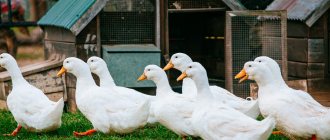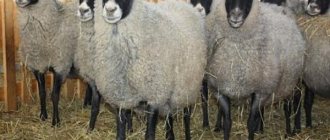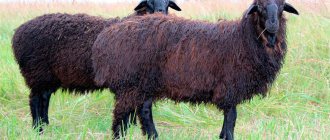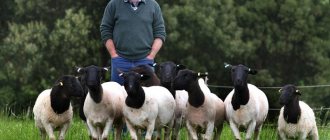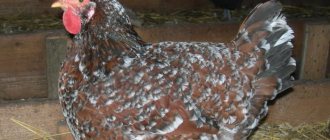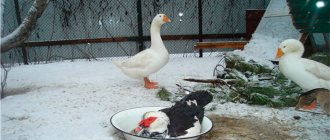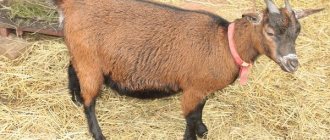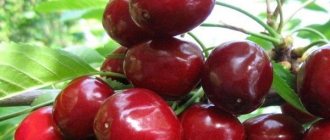Keeping young animals: subtleties for beginners
Raising sheep at home begins with organizing special conditions for lambs. It is not difficult to understand how to keep young animals; just read several popular manuals for livestock specialists. In the first days of life, the offspring are fed colostrum. For several days, the lamb is kept with the uterus in a separate pen, then the family can be combined with other sheep that have offspring.
Young individuals are the weakest, so they require special care
Young lambs are released into the general herd after 3 months. At this time, animals become completely independent and graze along with adults. The most difficult time to raise a lamb is until it is 3-4 months old; at this age it is especially vulnerable to infections and needs constant supervision. At the age of 8 months, the young animals begin to estrus; closer to 11 months, the young animals are able to give birth.
Sheep breeding usually occurs in autumn. At this point, the farm organizers must calculate how much of the young stock will be left for fattening and breeding, and how much will go for slaughter or sale. Depending on this, the supply of feed for the winter is calculated.
Animals need more careful care and high-quality feed; they must be vaccinated on time, and, if necessary, isolated from the general herd and treated. But properly raised purebred young animals can be sold profitably.
Construction of a shed (sheds)
Throughout the warm season, as soon as fresh green grass appears, the sheep are kept on free grazing. But for the winter, even the hardiest breeds need to build a home, or adapt an existing utility room for it.
Requirements for a sheepfold (shed):
- Good lighting.
- The floor is located above ground level at a height of 20–30 cm.
- Organization of a drainage system for removing waste products from sheep from the premises.
- The flooring should be covered with bedding (hay, straw).
- From the floor to the bottom frame of the window you need to maintain a height of 1.2 m.
- The presence of a thermometer - to control the temperature in winter and during the lambing period of females.
- The area should be divided into compartments for keeping queens, lambs, and rams.
- Availability of feeders and drinking bowls.
- Possibility of heating the room.
- Availability of a basic ventilation system.
Calculation of area depending on the desired livestock
The first step in building a sheepfold is calculating the area of the room. In accordance with sanitary standards, there should be 1.5 m² per adult, and 3 m² per ewe and lambs.
Room equipment
The entire sheepfold is divided into zones using shields 1.2 m high, consisting of boards, between which there should be a gap of 15 cm.
The width of drinking bowls and feeders is calculated depending on the number of animals. These devices should have a height of 30–40 cm and a length of 20 cm per individual.
Find out what the life expectancy of sheep is.
Sanitary condition of the premises
To prevent livestock from getting sick, sanitary standards must be observed in sheepfolds:
- change the litter as it gets dirty, about once a week (maybe more often);
- washing drinking bowls and feeders with gentle detergents every 3–5 days;
- disinfection of premises when transferring animals to free range (spring) and before putting them into a stall (autumn) - involves complete removal of floor bedding, washing the floor and walls with bleach, treating the entire premises with copper sulfate of 5% concentration, ventilation for a week.
Video: Setting up a sheepfold
Sheep breeds suitable for breeding
For home breeding of sheep, the best breeds remain those that produce large amounts of meat and wool. It is best to start raising these animals with the most common breed, which remains the Romanovskaya. It is this breed that can provide humanity with milk, meat and wool.
Balabas
There are other breeds that are not much inferior to the Romanovskaya.
Among them it should be noted:
- Balabas,
- Tushinskaya,
- Karachaevskaya.
In fact, there are at least thirty-nine of them that are suitable for home breeding.
Among the felt breeds, the best sheep are the Gissar breed, which belongs to the fat-tailed species. There are about one hundred and seventy-five breeding breeds in Russia. Among them, ninety-eight are fine-fleece, twenty-eight are semi-fine-fleece, forty-five are coarse-wool, four are semi-coarse-wool, and only two are meat breeds.
Each region raises its own special breed of sheep.
The main sheep breeding regions remain:
- North Caucasus,
- Southern Federal District,
- Volga region,
- Central Black Earth strip of Russia,
- Southern Urals.
Important! When buying an animal, you should carefully examine it to make sure that it is healthy, has a good physique, thick, shiny hair, and healthy and not loose teeth. Under no circumstances should you buy a sheep whose mucous membrane is inflamed or has formations or growths on its body.
When developing a plan for sheep breeding, you need to ask which breeds are most popular for breeding in Russia. These are:
- Gissarskaya are very large sheep. Weight - up to 180 kg.
- Texel is a Dutch breed. The meat is odorless. Hardy, takes root well in the middle zone.
- Romanovskaya - suitable for central and northern regions. Valuable wool.
- Karachaevskaya - valuable wool, high immunity. Adapts well to temperature changes and tolerates high humidity.
- Edilbaevskaya - suitable for the southern regions. Especially valuable meat. Capable of year-round grazing.
When forming a budget for the purchase of animals, you should expect that the minimum possible number of sheep is 200 individuals. With such livestock it will be possible to recoup the costs quickly.
Herd
Flock of Sheep Sheep
are herd animals that must graze together.
They are not distinguished by special intelligence, acuity of perception and memory; quite shy.
They do not have a clear hierarchy in the herd.
Everything is limited to the fact that the role of leader is played by a large ram, a donkey (in the southern regions) or a goat (their breeding is often carried out in parallel with sheep), sometimes a uterus.
These are conservative animals that have difficulty adapting to new conditions.
The number of heads that can be successfully cared for at the hobby level is 30 pcs. Over time, this figure can be increased to entrepreneurial scale - 500 units. In this case, profitability will go up, and keeping livestock will begin to bring tangible benefits.
The average numbers that suit most farmers are 130-150 sheep. At the same time, in the summer the livestock will increase to 190 units, and in the winter it will drop to 120. Therefore, by spring, during the breeding season, on average, about 100 sheep remain “on hand”.
Using this quantity (100 pcs.) as an example, we present the following proportion that must be observed by the farmer:
- three stud rams
- 40 sheep for slaughter
- the rest are little lambs that will kitten in early spring
Mostly male animals go under the butcher's knife. Sheep are necessary to maintain the reproduction of the livestock. They give birth 2 times a year (gestation period is 5 months) with 2-4 lambs. The uterus is slaughtered after 4 years of “service”.
Basic rules for caring for animals
- Animals must undergo regular veterinarian examinations and mandatory vaccinations (according to the vaccination schedule). To avoid outbreaks of various diseases and mass mortality of animals, new individuals must undergo quarantine before joining the herd;
- When raising sheep at home, you need to remember that their hooves need to be cleaned and trimmed from time to time. This procedure will keep your leg joints healthy. In addition, to prevent the hooves from being subjected to sudden hypothermia during winter frosts, care must be taken to ensure that the floor in the sheepfold remains dry and relatively warm (it is made of boards and covered with straw);
- Constantly ensure that the sheep’s diet contains a sufficient amount of salt (it is added to food) and vitamins, which are abundant in pasture plants and young green shoots;
- The process of mating and reproduction of animals must be controlled by keeping breeder rams separate from the herd;
- To manage the herd, the pasture needs to be equipped with electric fencing, and also to acquire guard dogs that will keep an eye on the cattle and guide them through the pasture in the right direction.
By the way, considering the idea of raising cows as a business at home, such shepherd dogs and “electric fencing” could also be very useful. After all, then the herd will be under constant supervision even when the owner of the animals is busy with other things.
In addition to following the above rules, before starting to raise sheep at home, a novice breeder needs to draw up a detailed business plan for breeding sheep, which clearly outlines the scale of the business and all the costs of its implementation. In particular, you must indicate exactly how many animals will be in your flock (this figure will affect the parameters of the sheepfold and the required supply of feed). In addition, this will allow you to calculate how much it will cost:
- Arranging a place to store a supply of hay (you need to prepare enough of it, since, along with other components, this is the main food for sheep in winter);
- Organizing a place for the process of walking animals (lambs should spend most of their time in the fresh air, so they need to be provided with walking even in winter);
- Arrangement of a place for storing sheep waste products.
The cost of purchasing a veterinary first aid kit, which must include:
- Products for treating skin lesions (chemi-spray or aluminum-spray);
- Preparations to combat foot rot (for example, tar, kubatol);
- Agistamines;
- Timpanol;
- Large enema, syringes, gastric tube, bandages, cotton wool, tourniquet.
The fact is that when planning to raise sheep as a business, the future farmer must be prepared for the fact that animals sometimes have problems with rumen swelling. And you can remove gases from the stomach with the help of tympanol, which is injected into the suffering animal, or by using a gastric tube. If the ram is not helped in time, it may die.
What diseases do sheep suffer from and the fight against parasites?
Sheep can become ill when exposed to damp or cold conditions for long periods of time . In this case, they may develop pneumonia. Sheep begin to cough, appetite decreases, and breathing becomes difficult.
Be sure to read:
Sheep of the Romanov breed: characteristics, description and advantages of breeding
Body temperature rises to 42-44 degrees. Treatment is with antibiotics (Biovit 80, bicillin, streptomycin). It is necessary to protect the flock, especially in winter, from drafts, and keep the animals warm and dry.
Sheep can suffer from rumen flatulence. The disease is manifested by loss of appetite, nervousness, and bloating. The reason is an incorrect diet. Treatment involves inserting a gas tube (through the mouth) and puncturing the scar.
In case of poisoning (by a poisonous plant), gastric lavage is performed.
To combat parasites, Thiabendazole is given; external parasites are eliminated by combing.
How to raise lambs?
- In the maternity ward, the temperature is maintained at 12–18°C. To prevent babies from getting too cold, the floors are covered with clean, dry hay;
- If there is a lack of sheep's milk, the lambs are fed heated goat's or cow's milk. At one week of age the daily dose is 200 g, at one month of age - 800 g;
- During the day, the females are kept and fed on a walk, and the babies are left in a warm house. To give them their mother's milk, the sheep are driven indoors every three hours;
- At two weeks of age, lambs begin to introduce bran, mixed feed, and crushed oats into their diet. They start with a portion of 50 g per day, and at three months they give 200 g;
- At three weeks, lambs have their tails docked for hygienic purposes. Rams intended for fattening are castrated;
- Older children are walked for an hour a day. In winter, the walking time should not exceed 15–20 minutes. In frost, rain or snow, lambs are not allowed outside;
- Starting from four months, milk is gradually replaced with adult foods. The females are driven away for fattening, and the babies are grazed in the cultivated meadows;
- Five-month-old lambs are divided into groups based on gender and formed into independent flocks.
Features of the diet of married and single ewes
The technology for feeding lambs at home must be fully observed and be no worse than in industrial pastures and factories. For sheep, if the farm is small, it is more profitable to provide the possibility of grazing on fresh grass in the warm season - only feed chalk and table salt are added to such a diet. In the summer, you can significantly save on feeding sheep, and besides, it is much easier to feed them. Among other things, it must be taken into account that the feeding ration must be balanced, and the sheep cannot be suddenly transferred from grass to hay and vice versa: such a transition must be made gradually by mixing different proportions.
It will take a week or a week and a half to switch to a new feeding regimen, so as not to cause additional stress on the gastrointestinal tract and its disorders. As for the winter diet of pregnant ewes, during the first half of pregnancy it does not differ from the diet of unfertilized females. It is better that there is no division of sheep in the flock into those that are pregnant and those that are not.
At a certain stage, differences in nutrition arise, so this causes additional troubles in the care process. The main diet of sheep consists of hay and concentrates, and root vegetables, chalk, and sulfur are introduced as additional complementary foods to provide the animal with a complex of necessary vitamins.
It is necessary to provide the sheep with vitamins
In nutrition, a significant place is given to proper diet. There is a misconception that in winter you can reduce the amount of water, which is a big mistake that can result in illness and depression of individuals in the flock. Water cannot be replaced with snow, as some believe: snow is distilled water and does not contain the necessary nutrients and substances.
It is important to pay attention to the temperature of the food for feeding, the same applies to the water supply: pregnant ewes should not be given cold water. It must be at room temperature, and during walking, a heated drinking bowl must be installed.
Sheep Breeding Basics
If you have never raised this species and are not familiar with the peculiarities of its life activity, then first of all you should visit an existing farm and consult with specialists and professional sheep breeders. Depending on the breed and climatic conditions, breeding of animals may differ slightly. But before delving into the intricacies of management methods, you need to find out what materials can be obtained from adult animals and how the costs of the sheepfold will be covered.
Main sheep products:
- Meat.
- Milk.
- Fat.
- Wool.
- Skin.
All of the above are successfully sent to markets and stores, as well as to specialized factories.
https://youtube.com/watch?v=HFEQ84gda0k
Mutton or lamb refers to dietary varieties of meat products. Therefore, raising sheep for meat is one of the most promising areas of livestock farming. Its main advantage is the presence of a large number of vitamins, microelements and amino acids. The carcass of this type contains 2-3 times less fat than pork and beef. Adipose tissue contains 4 times less cholesterol than other animals. And, as you know, the less cholesterol a person contains in his blood, the lower the risk of cardiovascular and cerebrovascular diseases. In other words, fewer heart attacks and strokes. Maybe this is the secret of the longevity of peoples for whom the diet of this meat is a cultural feature.
Dairy products are traditionally used by residents of Europe, Central Asia, the North Caucasus and Crimea. But now it has become available to the general consumer and on the shelves of dairy departments you can increasingly find products made from sheep milk such as:
- Matsoni.
- Yogurt.
- Katyk.
- Ayran et al.
Roquefort, Feta and feta cheese are also made from the milk of these animals.
It is impossible not to note such a classic material for sheepdogs as wool. This is the most popular type of sheep farm. You will not have any difficulties implementing it. Factories producing clothing and other fabric materials purchase it en masse.
The skins are sold for the manufacture of leather products. Lambskin leather is one of the softest. Exclusive clothing and accessories are made from it. Many famous fashion houses use only this variety. With proper dressing, you can make a significant profit from the skins alone.
Diseases and their treatment
The health of the livestock is one of the priority conditions for keeping. It is necessary to monitor the condition of animals.
Dangerous signs of the disease include the following symptoms:
- a sharp increase in body temperature;
- causeless twitching of the ears;
- lack of appetite;
- development of conjunctivitis;
- weight loss;
- lameness;
- cough.
Common sheep diseases can be cured if prompt action is taken.
| Disease | How to treat | Signs |
| Pneumonia | A course of antibiotics is prescribed, plenty of fluids are given, and the sheep is left in an individual pen until the condition improves. | Loss of appetite, cough, sudden change in body temperature. |
| Pulp inflammation | The rot is cut off and the hooves are treated with special compounds. | Bacteria enter the hollow spaces on the hooves and cause rot. The condition causes lameness. |
| Skeletal dystrophy | A course of vitamins is prescribed, the diet is reviewed, and an increased amount of vitamin E is added. | Weight loss, apathy, weakness, muscle atrophy. |
| Rumen flatulence | To alleviate the animal’s condition, a gas tube is inserted, the diet is reviewed, and fermented milk products are introduced for a while. | Violation of the diet provokes flatulence, bloating, loss of appetite, and weight loss. |
| Poisoning | Wash with salts and vegetable oil. | Vomiting, weakness, loss of coordination. |
| Bezoar disease | They are treated with vitamin supplements and injections of special medications. | Eating their own fur begins when animals lack certain substances in their diet. |
The appearance of lice on the body of sheep brings a lot of inconvenience. Animals begin to itch and behave restlessly. If sheep have lice, it is necessary to wash them with special means. Specially shorn sheep are treated with Diazinon solution. The next treatment is carried out after 2 weeks.
Expert opinion
Zarechny Maxim Valerievich
Agronomist with 12 years of experience. Our best country expert.
Ask a Question
Information! In addition to treatment with solutions, it is customary to carry out injections. Suitable drugs are: “Iverlong”, “Ivermec”.
How to register a business?
For beginners, sheep breeding at home can be organized as part of a personal farm. But the legal area of 2.5 hectares is enough, at best, to feed five or six animals. Therefore, an entrepreneur who wants to receive a more significant income must create an individual entrepreneur or peasant farm using the Unified Agricultural Tax system with the following OKVED codes:
OKVED sheep breeding
| 01.45 | Sheep and goat farming |
| 01.45.2 | Production of raw sheep and goat milk |
| 01.45.4 | Breeding sheep and goats |
It is impossible to breed sheep in Russia on an industrial scale without the approval of various authorities. To do this, you need to notify Rospotrebnadzor about the start of the enterprise’s activities and formalize:
- Project documentation for the farm;
- Permission from the local administration;
- Permits from the sanitary department and environmentalists;
- Permission from the fire department;
- Veterinary passports of animals;
- Certificates for meat and milk;
- VSD forms No. 2 and No. 3 for batches of meat and milk.
Finally, breeding meat sheep requires registration and subsequent entry into the invoice system for the shipment of goods. To do this, you need to obtain an electronic signature and log in to the site.
Preparing the sheepfold premises
In winter, to raise sheep for meat at home, you will need an insulated room. It can be built from wood, brick, adobe. But the easiest way is to buy and install a ready-made warm hangar. Its area is calculated taking into account the size of the livestock based on the following maintenance standards:
- For a breeding female - up to 1.2 m²;
- For breeding ram - up to 2.0 m²;
- For lamb up to one year - up to 1.0 m²;
- For a female with lambs in a greenhouse - up to 3 m².
Also, near the sheepfold, you should fence a small enclosure where the rams will walk and feed in the winter. As for the building itself, when arranging it you need to follow some recommendations:
- Floors can be made from any material except cold concrete. To combat dampness, their surface should be 20 cm above ground level;
- Thick, dry bedding will help provide the animals with comfortable conditions. For these purposes, 70–100 kg of straw per pet is stored for the winter;
- In a room for 50–100 sheep, natural ventilation is sufficient. If the herd is larger, you will have to install exhaust ventilation;
- In stalls for young animals and breeding animals, it is necessary to install drinking bowls, nurseries and feeders for grain feed;
- In addition to natural lighting, artificial lighting should be provided in the sheepfold. Extending daylight hours in winter increases the productivity of rams;
- To divide the herd into groups, you need to stock up on durable movable partitions made of wood or metal.
A warming house for lambs, and in cold areas the entire building must be heated with a stove. It is important to maintain certain climatic conditions indoors:
Conditions for keeping sheep
| Index | Sheepfold | Teplyak | Young stock workshop |
| Temperature, °C | 4–6 | 10–14 | 6–10 |
| Humidity, % | 70–80 | 65–75 | 65–75 |
| Air exchange to the head | |||
| Summer, m³/h | 0,8–0,9 | 0,5–0,6 | 0,3–0,4 |
| In winter, m³/h | 0,3–0,4 | 0,2–0,3 | 0,2–0,3 |
Equipment for raising sheep Some equipment for raising sheep for meat can be made independently, but you will have to buy special tools and equipment:
Number of offspring per year per sheep
Sheep are early maturing animals and are ready for insemination already at the age of one year. Pregnancy lasts about 5 months and, in most cases, ends with the birth of one or two lambs. But there may be exceptions.
What does it depend on
The number of lambs a female can produce will depend on several important factors:
- Breed affiliation. Mostly, the average number of babies per lambing for ordinary sheep is one or two. The exception is animals of the Romanov breed, which are capable of giving birth to up to five lambs.
- Diet. With a balanced diet supplemented with vitamins and minerals, a ewe can fully bear and give birth to up to two babies. Exhausted females have difficulty bearing even one lamb.
- Health status.
As a rule, a healthy sexually mature female can give birth from one to two or three times every two years in a year. Some ewes are capable of lambing up to four times every two years.
When can a sheep be bred again after lambing?
The postpartum period in sheep, that is, the time after lambing and before the restoration of the genital and internal organs begins, lasts about two weeks. At the same time, the labia and pelvic ligaments return to normal on days 3-4, the vaginal mucosa - on days 6-7, discharge and ligaments are restored after two weeks. 14-15 days after birth, the cervical canal closes, and all anatomical changes in the genital organs completely disappear after 24-28 days. The first sexual cycle in a sheep occurs 1.5–2 months after lambing, it is at this time that the female is ready for a new mating.
Did you know? Until now, scientists have not been able to create an artificial analogue of natural sheep wool that would be as good as the original in quality and ability to retain heat.
Winter sheep management
In the autumn, sheep are transferred to pens and specially equipped sheepfolds. It is very important at this time of year to protect the animal from drafts, excess humidity and overcrowding.
In winter, feeding is carried out outdoors or under a canopy 3-4 times a day. First, sheep should receive hay from cereals and legumes, harvested in the summer. It is necessary for rapid weight gain and growth. Then vegetable tops, fresh root vegetables, and potatoes with bran are added to the feed. After eating, the livestock is given plenty of water and is fed concentrated and roughage feed.
Sheep very quickly get used to the feeding schedule, so they are fed at specially designated hours. In the evening, caring farmers put hay and prepared brooms into the feeders.
Where to start raising sheep?
When drawing up a plan for a sheep farm, it is recommended first of all to pay attention to the following points:
- Registration of individual entrepreneurs.
- Breed selection.
- Conditions of detention and care.
- Features of feeding in summer and winter.
- Hired personnel.
- Implementation.
Start-up capital and material and technical base will depend entirely on the size of the herd. With a small quantity, you can build a stall yourself and graze on accessible and free land, which significantly reduces costs. Equipment for the pasture method is found in any rural yard. This is another positive factor for beginners to start raising such livestock profitably from scratch.
It is not recommended for beginners to immediately start herds of thousands of animals. To master this business, you should start with 7-10 sheep. In this case, registration of activities is optional. However, if you are engaged in sheep farming on a large scale, this must be done officially. The OKVED code “Sheep and goat breeding” will allow carrying out breeding work and selling products. If you decide to process milk, you will need to expand your legal powers and re-register.
Why do farmers raise sheep?
Livestock activities related to the breeding of sheep and rams are now popular and in demand in Russia and the world. The reasons lie both in the characteristics of the animals themselves and in the characteristics of the resulting products.
Advantages of sheep and sheep farming
This area of livestock farming is developing due to the positive physiological qualities of sheep, as well as due to uncomplicated living conditions. This is manifested in the following features:
- Sheep farming is a fairly profitable area of livestock farming and at the same time relatively uncomplicated. Acquiring and maintaining several individuals does not require large financial investments and physical effort. But there will always be a demand for the products received.
- Possibility of using areas previously traversed by herds of cattle for grazing flocks.
- There is no need for large areas for housing - sheep can easily tolerate crowded conditions in the herd.
- Undemanding when organizing maintenance in winter. These animals only need a warm and dry room with a small amount of straw.
Product profitability
Farmers receive significant benefits from the high commercial quality of products obtained from sheep farming:
- The resulting meat has an excellent taste. It is dietary, and therefore suitable for inclusion in the diet of both adults and children.
- Sheep milk is healthy and rich in nutritional components compared to, for example, cow milk. Not only classic cottage cheese and butter are made from it, but also cheeses, feta cheese, and yogurt.
- The resulting fat tail fat can be used in cooking, as well as in medicine as a remedy. In the latter case, it will be needed by people suffering from chronic diseases of the lungs, joint tissue and other ailments.
- Wool is suitable for making warm mittens, sweaters, and various winter clothing, which additionally produce a healing effect.
- Sheep skins can be used to sew sheepskin coats, hats, and shoes. They are popular as a finishing material for interior decoration and the manufacture of car seat covers.
- Sheep waste products are also used. Manure has a high level of heat transfer, and therefore it is applicable as a fertilizer.
Rams and sheep can be raised in all regions of Russia. It is important to remember that dampness is dangerous for these animals due to its negative impact on the immune system. Therefore, the barns must be dry; the herd should not be taken out to pasture in rainy weather.
To organize a sheep breeding business, large financial investments are not required. The animals are unpretentious and early maturing, which is associated with potential business profitability.
Stern
An important condition for successful sheep farming is the proximity of pastures, since in the summer season green vegetation is the main food for animals. For ten sheep, the pasture area is 1 hectare.
If sheep breeding is practiced as a business, additional artificial pastures of alfalfa, clover, and perennial grasses will be required. After using the plot, the land rests, there is the possibility of several crop rotations.
Grains and legumes should be added to grass-fed foods.
In the winter season, feed includes hay from legumes, cereals, oats, barley, and bran. It is recommended to use granulated feed and haylage. Place of keeping: Corrals fenced with boards are used as buildings for home keeping of rams; insulated sheepfolds are used for winter time. Inside the stall, the temperature must be above 8 degrees, an insulated roof with waterproofing and ventilation of the sheep farm, and dry straw bedding are required. The optimal height of the room is from 1.5 m. Windows are required for the penetration of daylight. Free access to the feeding area is required. Selecting a breed
If we consider raising sheep as a business, then the Romanov breed is recommended, producing up to four heads per year. Each sheep produces 2-4 kg of wool. A six-month-old lamb weighs about 60 kg, and by 11 months its weight reaches 80 kg. After the birth of the first offspring, sheep of this breed produce about 100 liters of milk, from which high-quality fermented milk products are obtained. Depending on the type of this breed, animals differ in physique, abundance of milk, fat, and wool.
Since seasonality affects the reproduction and development of livestock, this quite limits productivity. Therefore, sheep farming technologies include the following methods:
In breeding work, it is necessary to retain large female meat animals, and also to use artificial insemination, which reduces the risk of viral diseases and related sexual relations in the herd. Frozen semen of meat sheep helps increase the population and simplifies the work regarding the reproduction of offspring.
Profitable mini-farms
The success of the sheep breeding technology, based on a former farm, is explained by the rapid sale of products with a minimum number of intermediaries and compliance with the following nuances:
To transport rams, you will need trailers with a capacity of up to 200 heads. An optimally selected number of sheep allows you to rationalize the rearing process at intervals between the vacancy of the farm and the new import of livestock, clean and disinfect the premises, update the walking areas, and repair the sheepfold.
Principles of Animal Care
Mechanization and automation It has been estimated that wage labor accounts for up to 40% of the total cost of raising sheep, including about four people for herding, and human resources are also required for preparing feed. Therefore, with maximum mechanization of production, it is possible to improve the business while reducing costs.
A sheep handling apparatus is beneficial in the following conditions:
Since intensive feeding is required when raising sheep for meat, the workshop is set up taking into account the operation of several lines: preparation and grinding of feed, dosing of concentrates, final mixing and supply of components.
When mixing feed, their digestibility and nutritional value increases, which also reduces waste, but the main advantage remains the automation of the process on a sheep farm. Additional income: shearing The main goal is to raise sheep for meat as a business, but in addition, it is possible to receive additional income from shearing wool and sales of sheep skins. Electric shears are used to collect wool into felt and yarn, making it possible to shear nine sheep per hour. The properties of wool have the following indicators: density, type, color, shine, water permeability, elasticity, length, thickness, strength, crimp, spinning ability. Romanov breeds produce light and high-quality fur, unlike meat and greasy ones.
After considering the recommendations, it is easier for a beginner to assess whether it is profitable to raise sheep and what problems may lie in wait for a sheep farmer in the process of raising them. To avoid the complications of keeping pets, you should plan all expenses in advance.
Features of feeding sheep
In summer, the cost of feeding the flock is minimal. At this time, animals spend most of their time on pasture, so for normal nutrition it is only necessary to ensure optimal grazing conditions.
Lambs and adults have a unique ability to find food by moving slowly across a patch of meadow. This ensures normal weight gain. Animals enjoy a variety of fresh grass. During the drives, experienced farmers control the speed of movement of the flock. Animals should not be left in one area for a long time, since the vegetation will be trampled down and adequate nutrition will not be possible.
If the grass cover is poor, you will need to supplement the diet with concentrates. They are given at a ratio of 300 g per lamb. If there is no possibility of grazing in summer, the herd is given freshly cut grass, which is quite difficult for the owner. In the pasture, care should be taken to install a drinking bowl, and it is advisable to leave a lick stone there.
To ensure a normal feeding process, you should choose the right place to install the feeder. At the same time, it should be positioned so that it is convenient for animals to eat food, and for farmers to add food to it. The best option would be to use a structure with a sloping bottom. It should be a nursery type feeder. Sheep will be comfortable if the height parameters of 20-25 cm are met.
In winter, you should take care of some changes in your diet. The food includes hay and supplements. The flock is fed with mixed feed and root crops. We should not forget about a sufficient volume of water. Its deficiency can provoke thermoregulatory failures.
Hay should be prepared in advance and stored properly. However, the diet needs to be varied:
- bran;
- vegetables and root vegetables - beets, carrots, potatoes, etc.;
- grain crops - corn, wheat, oats, rye;
- cake and silage.
It is recommended to pamper sheep with nutritious food during the day, and to give less nutritious food in the morning and evening hours. Before giving the animals concentrated food, the flock is watered, and silage is given before the animals approach the drinking bowl.
It is important not to deprive the sheep of salt and chalk. However, these animals are picky, so they may refuse contaminated chalk. In this case, it is advisable to mix forage with chalk at the rate of 100 g of chalk per 10 kg of crushed oats.
The highest rate of weight gain in sheep is ensured by the inclusion of green feed and legumes - clover, alfalfa - in the diet. In this case, the daily feed requirement is for:
- rams – up to 10 kg;
- sheep – up to 8 kg;
- young animals - 5-6 kg.
Pregnant and pregnant queens should be fed intensively. At the same time, it is important to control the quality of feed in order to exclude poisoning, which could result in the ejection of the lamb.
Young animals are slaughtered for meat at 3-9 months of age. At an older age, when the individual has reached 1 g, the meat begins to lose its consumer qualities. To speed up wool growth, sheep are given methionine. This is a drug in which a sulfur-containing amino acid is present in high concentrations.
Sheep breeding
Sheep have a very valuable quality. They are able to eat the most inexpensive food. By comparison, if eight hundred species of different plants grow on a pasture, then sheep eat at least four hundred of them, while cows eat only one hundred and fifty species, and horses only ninety.
Animals have the ability to actively move and endure the most difficult conditions. Thanks to the anatomy of the structure of the head and teeth, they can graze on very short grasses and can find food for themselves even in places where there is practically no vegetation.
Sheep breeding
Sheep live for fourteen years, but the most productive age is considered to be six- and eight-year-old individuals. Little ones that are six to seven months old can be called adults. It is customary to allow them to mate no earlier than a year and a half after birth.
Lambs suckle for five months. If the egg is bred to produce milk, then the period must be reduced to forty-five days. In most cases, the udder of sheep has two teats, but there are cases when there are significantly more of them.
Most often, animals are bred for wool. It is used to make fabrics and woolen threads, from which excellent warm clothes are knitted, and shoes are also felted.
In addition, they produce excellent meat - lamb. It has beneficial properties and contains a large amount of proteins. Excellent cheese is made from animal milk, which is also highly valued for its beneficial qualities.
How to care for sheep?
To effectively use the natural food supply in the summer, the herd is constantly kept on pastures, driving the rams into stalls only at night. This method of keeping determines the list of measures for caring for livestock:
- Animals begin to graze when the daytime temperature in spring is set at 5–8°C, and at least five-centimeter grass grows in the meadows;
- The flock is driven out to pasture early in the morning. At lunchtime, the rams rest in shaded areas near watering holes. Grazing ends before dusk;
- The veterinarian examines the animals monthly, identifying weak or pregnant animals. In order not to catch sheep in the meadow, you can do this near the feeders;
- In rainy weather, the rams are fed under a canopy. Wet wool takes a very long time to dry, and therefore animals can catch a cold;
- Blood-sucking insects cause trouble for the herd. The rams are regularly checked, parasites are removed and wounds are disinfected.
During the cold season, animals spend the night in a warm sheepfold. But if the weather permits, during the day the animals are taken out to the walking area. Staying in the fresh air improves the health of rams, improves their appetite and improves the quality of wool. What else needs to be done in autumn and winter:
- In preparation for wintering, they stock up on hay and vegetable feed, clean and disinfect the sheepfold premises;
- A month before transfer to the stalls, all veterinary procedures are carried out - animals are vaccinated, they are given drugs against worms and scabies;
- Before the rams are released, the floors in the sheepfold are covered with straw bedding. Every day after manure removal, new portions of bedding material are added;
- Feed troughs and drinking bowls are cleaned daily. On cold days, it is advisable to warm fresh water to room temperature;
- Every 3–4 months, animals have their hooves trimmed and cleaned, removing horny tissue. In winter, due to lack of movement, hooves grow especially quickly;
- For rams of fine-wool breeds, the hair around the eyes that bothers the animals is cut off as necessary.
Purchase (rent) of land, premises and equipment
Sheep are unpretentious animals; various types of pastures can be used for their grazing. Sheep farmers use both natural grazing and artificially created pastures; they are specially sown. For sowing, both perennial grasses (alfalfa, sweet clover, clover) and annual herbaceous plants (sorghum, winter rye) are used.
The type of keeping animals on pasture is advantageous in that feed and labor costs are reduced. This method is well suited for large livestock, but also requires extensive pastures, so 1 sheep requires from 0.2 to 1 hectares. Many farmers use feedlots for grazing, where grass clippings and mineral supplements are brought in in the summer.
Abandoned state farms, farms, and villages are well suited for pasture and premises (sheds for housing sheep). Renting such land will be inexpensive - about 1000 - 5000 per 1 hectare. Near the pasture there must be a body of water - a river or lake. If there is no natural source of water nearby, you need to create an artificial reservoir.
Any room that matches the size is suitable for keeping sheep. So, for one sheep you need about 3 sq.m., so for a herd of 300 heads - 900 sq.m. It can be a building with concrete walls, but the floor must be wooden, raised 25 cm above the ground, covered with hay. There should be a feeding trough in the room (40 cm per sheep).
It is necessary to carefully monitor the hygiene of the animals, the room must be ventilated, and the pen must be cleaned regularly. Rams are resistant to cold, so heating is not required. But in case of abnormal frosts, you can use a potbelly stove. On the pasture you also need to organize a wooden pen for animals and several storage sheds for feed and equipment.
As provided in the business plan, you will need a van truck for transporting livestock and feed, sheep shearing machines, refrigeration equipment for storing meat and work equipment (forks, shovels, buckets, etc.).
Hair cutting
The best time to trim animals is in the spring. Sometimes this procedure can be repeated in the fall if the coat has grown sufficiently. The coarser the sheep's hair, the faster it grows, which means that such individuals need to be cut more often - about three times a year.
It is important to assess the weather outside before starting shearing: it must be warm, otherwise the sheep, devoid of wool, risk getting sick.
Sheep shearing process
Prices for sheep and ram clippers
Shearing
Before shearing, the animals should not be fed or watered for about twelve hours so that the process takes place in a calmer environment. Sheep need to be sheared with a special clipper. Lay out the cut wool in layers on a bulky canvas so that it dries and ventilates slightly, and then you can collect it in bags or other containers.
Sheep clippers are currently a highly sought after item at the farmers market to make life easier for the farmer. In a special article, we will analyze popular models of equipment and tips on how to properly handle animals during grooming.
Video – Shearing a ram with a clipper
Expenses and income
Let's look at the financial part of a sheep breeding business plan and calculate how much it costs to open such a business. The advantage of this niche is that you can start with a very small initial investment and then gradually develop the business by investing your own funds.
| Name | Sum |
| Initial costs | |
| Buying sheep | 900.000rub |
| Ground repair and equipment | RUB 300,000 |
| Inventory | RUB 30,000 |
| Business registration | 20.000rub |
| other expenses | RUB 150,000 |
| Total: | 1.400.000rub |
| Monthly expenses | |
| Communal expenses | 15.000rub |
| Feed | RUB 30,000 |
| Land lease | 20.000rub |
| Total: | 65.000rub |
Let's say we have 100 sheep. In this case, the calculations will be as follows:
Wool
— 400,000 rub.
Meat
- 700,000 rub.
Milk
- 400,000 rubles
Revenue for the year
- 1,500,000 rubles
Monthly profit
- 60,000 rubles
Payback
- 2 years
| - I, SHEEP WOLF!!! — And you, you can create your own personal business plan with automatic and up-to-date calculations for 2020! | |
| DRAFT A BUSINESS PLAN FOR FREE |
QUICK CALCULATOR
Calculate the estimated profit, payback and profitability of your business in 14 seconds.
1
Initial investment, rub. Monthly expenses, rub.
2
Selecting a calculation method:
based on the average receipt from the sale of products and services
Markup, % Cost, rub. Number of sales per month
Unit production costs products/services, rub. Enter the cost of the product/service, rub. Number of sales per month
3
—
CALCULATE
RESULTS
Profit for the month:
Payback:
Profitability:
Sheep farming: advantages, technology
This business has many advantages over other types of livestock farming:
- Sheep are very unpretentious and rarely get sick.
- They do not require a special diet; it is enough to keep them on natural grazing in the summer and feed them with harvested hay, straw, wheat or other feed in the winter.
- Easily cope with frosts. Only for lambs you need a heated room so that the temperature in the shed is not lower than 10º C.
- The average lifespan of an animal is 20–25 years.
- An adult produces offspring for 8–10 years.
Now about technology. The bottom line is that a businessman buys 4-month-old lambs, fattens them, and subsequently resells them as live goods or sells cut meat.
You can buy young animals in the spring, in April-May, but keep in mind that at this time prices are at their highest. In July-June, farmers begin to export animals en masse for sale, so they can be bought more profitably.
Sheep grow quickly, and by the end of autumn they gain 80% of the weight of an adult (60–65 kg). This is the optimal time to sell livestock for meat. Be sure to vaccinate lambs and, if kept in stalls, sanitize them against parasites.
Marketing part
This chapter of the document is responsible for product sales and pricing. To do this, you need to carefully study the competitive environment and research the market in order to correctly perform pricing. Considering that a business can be implemented in several directions (sale of meat, milk, wool, live cattle), it is necessary to analyze the market in all segments.
Sales of products
When setting your price, consider the following nuances:
- calculate the cost of the product before setting the price;
- focus on supply and demand in the market;
- The maximum profit margin depends not only on price, but also on expenses.
Receipt and sale of products
Sheep farming allows for marketing activities in three directions: milk, meat and wool. In order to ensure continuity of the process, it is necessary to establish distribution channels even at the stage of purchasing animals.
It is better to sell meat and milk on a contractual basis with large suppliers. These could be supermarkets, shops, catering establishments.
The existence of a contract imposes obligations on both parties. On your part, you will be required to ensure that fresh meat is supplied in accordance with established sanitary standards. The buyer undertakes to pay in full for the ordered goods.
Selling live goods
Another sales option is to sell meat and milk to resellers, but this will significantly reduce income and affect profitability.
The sales option can be implemented in two directions:
- sales of live products;
- sale of already cut meat.
The first option is easier to organize, but in this case the buyer purchases the entire batch from you at a wholesale price.
The second option requires hiring additional staff, but in this case the profit will be higher. It will be necessary to additionally organize a slaughterhouse and hire a butcher. In addition to selling meat, selling wool can be an additional source of income.
You can negotiate with mills and private enterprises that will purchase wool in bulk during shearing. Thus, you fully sell the product. In addition to wool, you can also donate tanned skins of slaughtered sheep, which are in great demand today. To sell this product, study the demand among shoe and leather goods enterprises and enter into agreements for the supply of products.
Just betting on selling wool is not worth it. The price of wool is low and in order to achieve good profitability, you need to have a farm for 1,000 heads or more.
Sales of milk
Another sales area could be the sale of milk and dairy products. But, unlike cow's milk, sheep's milk is not as popular in the market. Therefore, if you retail it privately, it will take a long time. In addition, it will be necessary to include transportation costs in the financial section.
The optimal solution would be to conclude an agreement with a dairy processing plant or public catering facility that needs these products.
As an expansion of production, you can further consider opening your own workshop for tanning hides, producing sheep cheese, and sewing leather goods from sheep skin.
Breed selection
But, before we talk about breeds, let’s figure out how many animals need to be purchased in order to answer the question: “Is breeding sheep profitable?” — sounded positive. Moreover, everything is simple here - you can earn income by raising even 3-5 sheep. The calculation is easy to do.
A female ram can produce from 1 to 5 lambs per year, which means the number of your flock will at least double. And this means that you will already “recoup” the invested funds and continue to work in profit. When the flock reaches the planned number (let me remind you, it all depends on your ability to provide the animals with conditions for growth, nutrition and reproduction), then raising sheep at home for beginners can easily become a more serious matter of selling both lamb and live sheep with high turnover and solid earnings. But this is true, by the way. But in fact, for a novice sheep breeder it is quite enough to have a small flock of 15-20 individuals. The main thing is to select animals that can quickly gain weight, and the ewes show good fertility. As for breeds, the most popular in Russia are:
Romanovskaya
Her main feature is her high fertility, which is also a bit of a “minus”, because sometimes she does not have enough of her own milk to feed the entire offspring. Then the sheep farmer needs to take care of feeding the babies artificially using goat milk (several goats are bred for this purpose). Another feature of the Romanovskaya is its good, thick coat. Therefore, if you are planning on breeding rams, then the Romanovskaya is an excellent option, which is guaranteed to bring the farmer maximum profit from the sale of sheep and meat.
Gissarskaya
This breed can be offered to those who are looking for an option for breeding purebred rams for breeding. Adult males are very large in size, and their weight can reach from 150 to 180 kilograms. Females are slightly smaller - 120 kilograms. The advantage of the Hissar lamb is that the lambs are born quite large, grow quickly and gain weight, and do not require any special care. Such a herd is simply a storehouse of meat; therefore, any breeder will want to have this breed. That is, by breeding her for a tribe you can make good money.
Karachevskaya
A breed that can easily take root in any climatic conditions. It is characterized by excellent immunity, has high quality wool, which, moreover, is very easy to process. It can be an excellent option for breeding sheep at home for beginners.
Edilbaevskaya
A breed that is characterized by rapid growth. But the main feature is fat tail fat and very fatty milk, which is used to prepare fermented milk products, as well as cheese butter. In a mild climate, these rams can be released for free feeding all year round.
Having decided on the breed, you may have a question - where to buy? In fact, buying rams is not so problematic. The required animal breeds can be found:
- On the market;
- Livestock farms;
- Buy from professional breeders.
The main problem is that when buying lambs, you do not encounter unscrupulous sellers who can slip you culled animals. Therefore, before purchasing, you should consult with a veterinarian or even invite him with you (he will be happy to help you for a fee). Well, if you are interested in questions about how to become a sheep farmer, how to develop a serious business in this matter, then you simply must learn to choose good animals yourself. And here are some tips on how to do this:
- Until you have learned to see the difference between a completely healthy ram and a slightly sick one, you should not buy lambs that are still very susceptible to various diseases. Buy adults;
- When buying adult animals, for example, sheep, that are ready to give birth, you can learn a lot of information from their owner. After all, she has already experienced several births, she is accustomed to people, has immunity to parasites and stress;
- Don’t be shy and ask about everything that interests you (health, productivity, why animals are sold (good sheep, unless, of course, they were bred for breeding, they are not sold. They only sell culling and you need to find out what its problem is. Perhaps for you this won't be a problem)?
- In order for the herd to be productive, it must be formed in such a way that there are no more than 5 sheep per adult breeding ram. If after lambing there are more lambs in your flock, there is no need to worry. The number of males and females in a flock is easily regulated by the method of slaughtering culled lambs.
Keeping animals on a farm
This is not to say that rams are whimsical animals. But, despite this, it is necessary to take care of their comfort, because living conditions absolutely affect the productivity of animals. If you don't pay enough attention to these individuals, you run the risk of not getting enough meat or wool. This is why it is important to think about keeping animals on a farm.
To do this, you will have to build a fairly large space with a height of about one and a half meters (make the exact height so that it is convenient for you to be there). The main condition when creating a sheepfold is the correct calculation of space - for each head there should be at least three square meters.
Pasture and walking are necessary for sheep at any time of the year
It is important to make the room so that moisture does not accumulate there. Dampness has a very bad effect on rams, as a result of which serious health problems can arise (foot diseases, diseases of the respiratory system, fungal inflammation).
It is better to use concrete for the floor. It must have drains into which urine and other impurities will go. On the concrete you need to lay out a large layer of bedding, which can be straw or sawdust. Every day you will have to clean the sheepfold from manure, and you will certainly replace the bedding with a new and clean one every few days.
Setting up a sheepfold
As we already said, it is important to consider the climate conditions of your location. If you choose breeds of sheep that can withstand frost, you don’t have to install heating in the barn. However, it is imperative to seal the holes in the walls to prevent drafts from entering. The room temperature should not fall below 14 degrees.
Important point! The place for pasture will have to be changed every three years, since the sheep trample down all the grass, after which it will stop growing at all. If your herd has about a hundred individuals, the pasture should be at least ten hectares.
